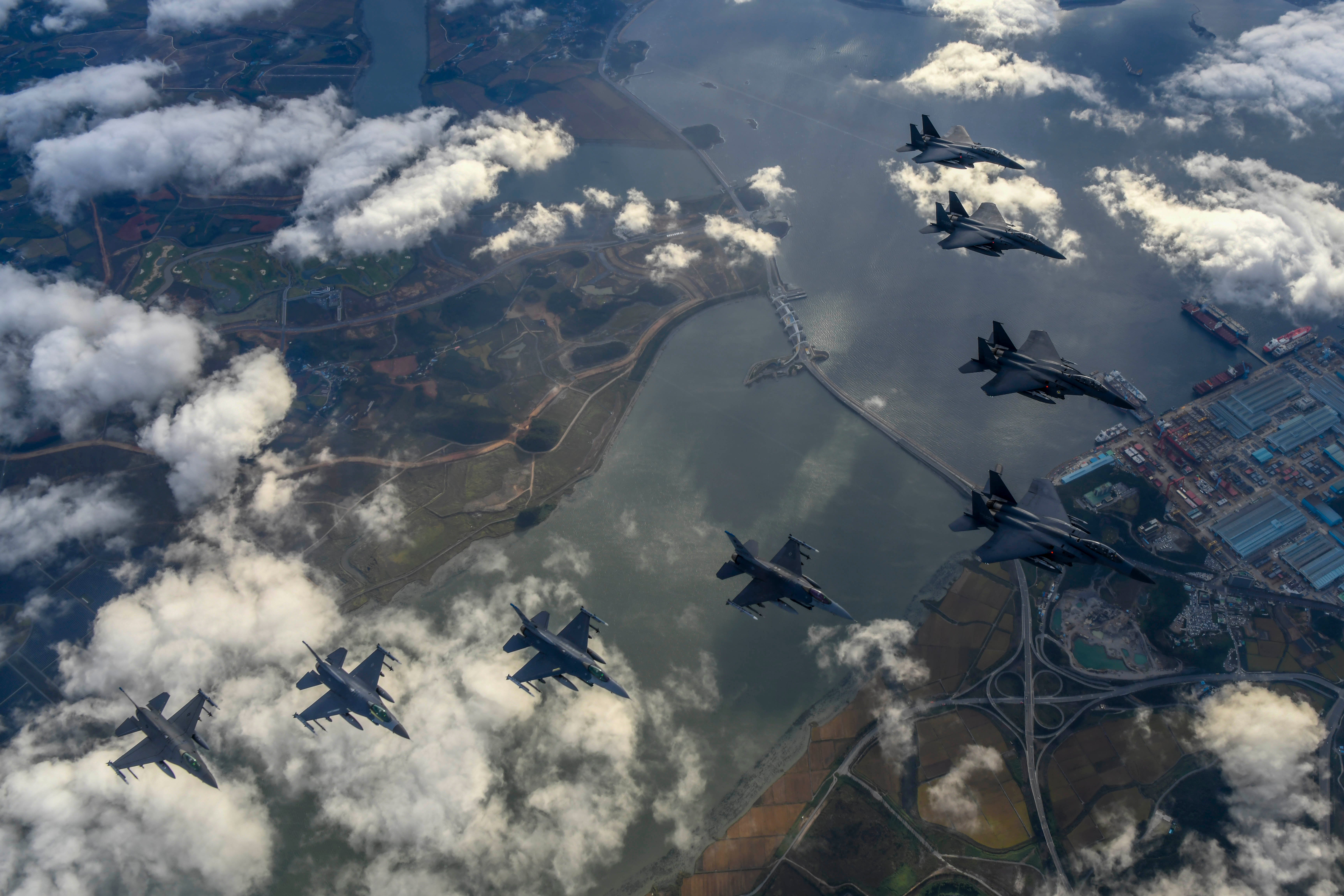South Korea scrambles 30 fighter jets in response to sortie by 12 North Korean warplanes
The North reportedly sent eight jets and four bombers near its border with South Korea
Your support helps us to tell the story
From reproductive rights to climate change to Big Tech, The Independent is on the ground when the story is developing. Whether it's investigating the financials of Elon Musk's pro-Trump PAC or producing our latest documentary, 'The A Word', which shines a light on the American women fighting for reproductive rights, we know how important it is to parse out the facts from the messaging.
At such a critical moment in US history, we need reporters on the ground. Your donation allows us to keep sending journalists to speak to both sides of the story.
The Independent is trusted by Americans across the entire political spectrum. And unlike many other quality news outlets, we choose not to lock Americans out of our reporting and analysis with paywalls. We believe quality journalism should be available to everyone, paid for by those who can afford it.
Your support makes all the difference.South Korea scrambled 30 military planes in response to 12 warplanes that North Korea flew near the border with its neighbour in an apparent bombing drill on Thursday.
The country’s military said eight North Korean jets and four bombers flew in formation, and are believed to have conducted air-to-surface firing exercises.
South Korea has not yet shared further details over how close to the border the North Korean jets flew.
Earlier, North Korea had fired two short-range ballistic missiles towards its eastern waters in the direction of Japan as a US aircraft carrier and allied warships held a drill simulating shooting down of one of the North’s missiles.
The North has so far launched about 40 missiles this year, including its largest intercontinental ballistic missiles, with officials in Seoul and Washington believing the country appears to be ready to hold its first nuclear test since 2017.
The latest missile launches suggested leader Kim Jong-un is determined to boost the country’s nuclear arsenal as he aims to defy international sanctions. Many experts believe his eventual goal is to force the US into recognising Pyongyang as a legitimate nuclear state and getting the sanctions lifted.
The latest missiles were launched 22 minutes apart from the North’s capital region and landed between the Korean Peninsula and Japan, said South Korea’s Joint Chiefs of Staff. While the first missile flew 350km, reaching a maximum altitude of 80km, the second flew more than double the distance, covering 800km on an apogee of 60km.
The flight details were similar to Japanese assessments announced by defence minister Yasukazu Hamada, who confirmed the missiles didn’t reach Japan’s exclusive economic zone.
He, however, added that the second missile was possibly launched on an “irregular” trajectory, a term used to describe the flight characteristics of a North Korean weapon modeled after Russia’s Iskander missile, which travels at low altitudes and is designed to be maneuverable in flight to improve its chances of evading missile defences.
The launch followed the return of the carrier, USS Ronald Reagan, to waters off the Korean Peninsula and occurred an hour after North Korea condemned the US for talking to the UN Security Council about Pyongyang’s “just counteraction measures” on joint South Korea-US drills, suggesting its missile tests are a reaction to the allied military moves.

It was the sixth missile launch in 12 days and the first since North fired an intermediate-range missile over Japan on Tuesday, prompting joint South Korean and US missile drills in which one weapon crashed and burned.
The launch was reported by South Korea’s joint chiefs of staff and the Japanese government.
South Korea’s military said it also boosted its surveillance posture and maintains readiness in close coordination with the US, while the US Indo-Pacific Command said the launches didn’t pose an immediate threat to the country or its allies, but still highlighted the “destabilising impact” of North Korea’s nuclear and ballistic missile programs.
South Korean president Yoon Suk Yeol and Japanese prime minister Fumio Kishida spoke on phone o Thursday and agreed that North Korea’s recent missile tests are “a serious, grave provocation” that threatens international peace.
The two leaders also decided to cooperate to sternly deal with North Korean provocations, according to Mr Yoon’s office.
Mr Kishida earlier said the North’s continued launches were “absolutely intolerable”.
“This is the sixth time in the short period, just counting the ones from the end of September,” he said. “This absolutely cannot be tolerated.”
Earlier on Wednesday, the US had accused China and Russia of enabling Mr Kim by blocking attempts to strengthen UN Security Council sanctions on Pyongyang.
Mr Yoon and Mr Kishida also said a clear message must be sent to North Korea that its provocation would bring consequences, the former’s office said.
The leaders also condemned the North’s recent tests as acts of serious provocation, it added.
Tokyo lodged a “vehement protest” with North Korea over Thursday’s launches through delegations in Beijing, the Japanese defense minister said.
“North Korea has relentlessly and unilaterally escalated its provocation especially since the beginning of this year,” Mr Hamada told reporters.
Additional reporting from agencies





Join our commenting forum
Join thought-provoking conversations, follow other Independent readers and see their replies
Comments